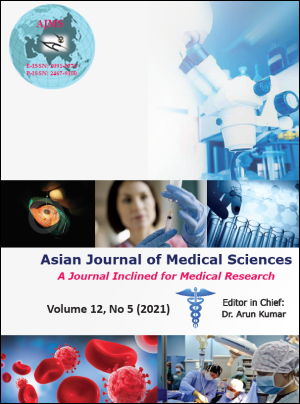A quantitative assessment of body iron status and its relationship with glycemic control in patients of type 2 diabetes mellitus in a tertiary care hospital of Kolkata
Keywords:
Serum Ferritin, Serum Iron, Transferrin Saturation, HbA1C, Type-II DM, Oxidative stressAbstract
Background: Diabetes is one of the most common disease which is observed in every household of Indian population. The longevity of the diabetic patients is dependent upon the frequency of complication and comorbidity that they encounter. Serum iron and ferritin, both being the aggravators to the oxidative stress accelerating the development of complications, gives us the reason to venture into the territory exploring the possibility of monitoring the body iron stores and taking prevent measures to control such complication. The current study was designed with an aim to knot the relationship between body iron stores and glycemic control in patients of type-II diabetes mellitus.
Aims and Objectives: To measure the levels of serum ferritin, serum Iron, transferrin saturation and HbA1C and finding out the relationship between body iron stores and glycemic control in patients of Type-II Diabetes Mellitus.
Materials and Methods: A total of 50 diagnosed cases of type II DM and 50 healthy controls between the age group of 35-65 years were taken following inclusion and exclusion criteria. Body iron stores were assessed by measuring serum ferritin, Serum iron and Transferrin saturation and Glycemic control was assessed by measuring levels of HbA1C.
Results: A significant increase in serum ferritin, serum iron and Transferrin saturation (P<0.001) was noted in diabetic patients as compared to controls. There was a positive correlation between serum iron and transferring saturation in the diabetic patients.
Conclusion: The co-morbidities and complications in the Diabetic population can be prevented by monitoring Body iron stores as they can significantly contribute to the oxidative stress leading to the complication and decreased life expectancy. Early detection in the abnormality in the body iron store can help us in employing proper measures for a better management of Type-II diabetic patients and thereby improving their survival.
Downloads
Downloads
Published
How to Cite
Issue
Section
License
Authors who publish with this journal agree to the following terms:
- The journal holds copyright and publishes the work under a Creative Commons CC-BY-NC license that permits use, distribution and reprduction in any medium, provided the original work is properly cited and is not used for commercial purposes. The journal should be recognised as the original publisher of this work.
- Authors are able to enter into separate, additional contractual arrangements for the non-exclusive distribution of the journal's published version of the work (e.g., post it to an institutional repository or publish it in a book), with an acknowledgement of its initial publication in this journal.
- Authors are permitted and encouraged to post their work online (e.g., in institutional repositories or on their website) prior to and during the submission process, as it can lead to productive exchanges, as well as earlier and greater citation of published work (See The Effect of Open Access).




